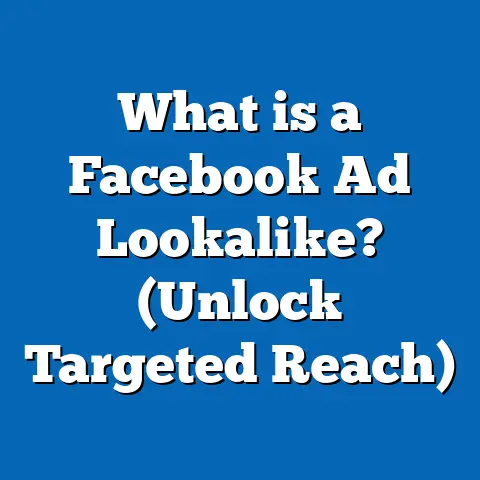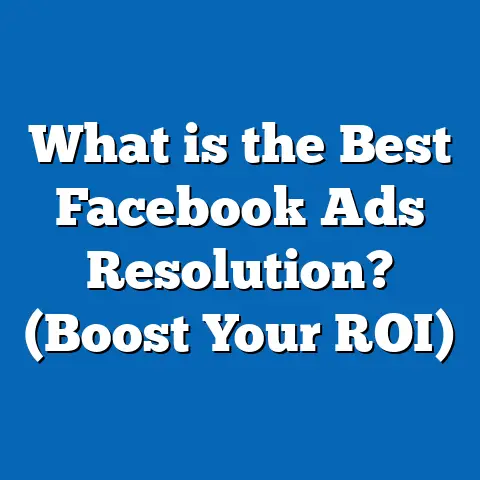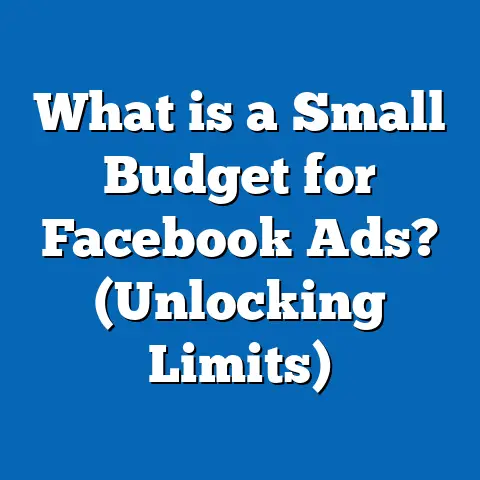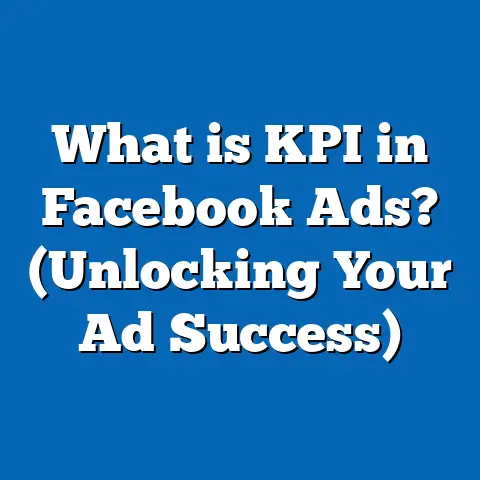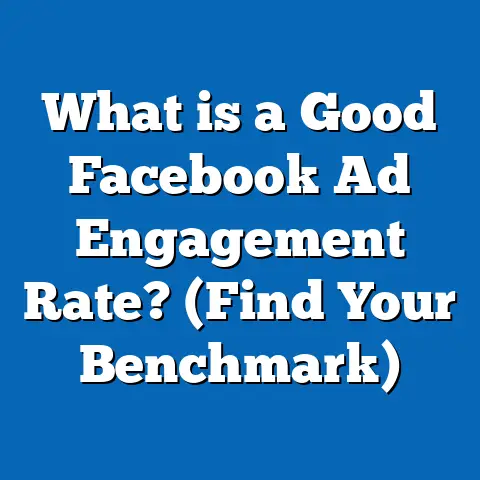What is LTV in Facebook Ads? (Unlocking Profit Potential)
What is LTV in Facebook Ads? (Unlocking Profit Potential)
When it comes to maximizing the return on your Facebook advertising investment, the most powerful concept you should master is Customer Lifetime Value (LTV). Unlike traditional metrics that focus solely on immediate sales or clicks, LTV provides a deeper insight into the true worth of each customer over time. This metric not only guides smarter ad spending but also fundamentally changes how you approach growth.
Facebook Ads are among the most popular tools for businesses looking to scale rapidly. Yet many advertisers fall into the trap of optimizing for short-term gains — like cost per acquisition (CPA) or first purchase conversion — missing out on the bigger picture: the long-term profit potential of each customer.
This guide will explain what LTV means in the context of Facebook Ads, why it matters more than ever, and how you can harness it to unlock sustainable profitability. We will cover foundational concepts, practical measurement techniques, advanced strategies, detailed case studies, pitfalls to avoid, and comparisons with other platforms. By the end, you will have a robust framework to integrate LTV into your Facebook marketing and advertising campaigns.
Understanding Customer Lifetime Value (LTV)
Defining Customer Lifetime Value
At its core, Customer Lifetime Value (LTV) represents the total net revenue a business expects from a single customer over the entire duration of their relationship. This includes all purchases, subscriptions, upsells, cross-sells, and recurring revenue streams attributable to that customer.
This metric shifts focus from a single transaction to a holistic view of customer profitability. It accounts for repeat purchases, brand loyalty, and customer engagement that extends well beyond the first sale.
Why LTV is More Important Than Ever
In today’s highly competitive digital landscape, acquiring new customers is becoming increasingly expensive. According to a 2024 report by HubSpot, the average Customer Acquisition Cost (CAC) across industries has risen by 23% in the last five years. Yet many businesses still optimize Facebook Ads campaigns primarily for initial conversions or leads.
Without understanding LTV, businesses risk overspending on customers who generate little long-term value or missing growth opportunities by not nurturing high-value segments.
Components of LTV Explained
The classic LTV formula looks like this: LTV=Average Purchase Value×Purchase Frequency×Customer LifespanLTV = \text{Average Purchase Value} \times \text{Purchase Frequency} \times \text{Customer Lifespan}
Breaking it down further:
- For subscription models: LTV = Average Revenue Per User (ARPU) × Customer Lifetime.
- For SaaS businesses: LTV might factor in churn rates and monthly recurring revenue (MRR).
The Impact of LTV on Business Decisions
Understanding LTV informs critical decisions such as:
- How much to spend on acquiring a new customer.
- Which customer segments to target or prioritize.
- What retention strategies to implement.
- How to forecast revenue growth.
Here’s an example: If your average LTV is $300 and your CAC is $100, you know you make $200 profit per customer on average. This allows you to confidently invest in scaling acquisition campaigns.
The Role of LTV in Facebook Ads Strategy
Beyond Short-Term Metrics: Why Focusing on LTV Matters
Most Facebook advertisers optimize for metrics like Cost Per Click (CPC), Click-Through Rate (CTR), or Cost Per Acquisition (CPA). While these are useful for initial campaign setup, they do not guarantee profitability over time.
LTV instead focuses on return on ad spend (ROAS) from a long-term perspective. For example:
- If you spend $50 to acquire a customer who spends $75 once but $500 over two years, optimizing solely for CPA misses this big picture.
The Gold Standard: LTV to CAC Ratio
A widely recommended benchmark is an LTV:CAC ratio of at least 3:1. This means the lifetime revenue generated should be three times the cost of acquiring that customer for sustainable growth.
Recent data from ProfitWell shows companies with LTV:CAC ratios above 3 have 50% higher profit margins and significantly better cash flow stability than those below this threshold.
How LTV Influences Facebook Campaign Objectives
Facebook allows advertisers to optimize for different objectives such as conversions, catalog sales, lead generation, traffic, or store visits. When using an LTV-based approach:
- You optimize campaigns for value, rather than just conversions.
- Facebook’s algorithm uses historical data to target users likely to generate higher lifetime value.
- You can leverage value-based lookalike audiences, which Facebook creates from your highest value customers instead of generic purchasers.
Measuring LTV in Facebook Ads: Tools and Techniques
Setting Up Your Measurement Infrastructure
Accurate LTV measurement depends on reliable data collection systems:
- Facebook Pixel: This JavaScript code tracks user actions (page views, purchases) on your website after interacting with an ad.
- Conversion API: Server-side tracking that complements Pixel data by sending purchase events directly from your server to Facebook.
- Advanced Matching: Improves user identification by matching hashed customer data (emails, phone numbers) with Facebook profiles.
- Offline Event Tracking: Captures sales occurring outside digital channels but linked to Facebook campaigns.
Together, these tools build a detailed picture of how users engage and convert over time.
Calculating LTV from Facebook Data
Facebook Ads Manager provides data on purchase events with revenue amounts. To estimate LTV:
- Track repeat purchases from customers acquired via Facebook over months.
- Segment customers by acquisition date and monitor total revenue generated.
- Use spreadsheet models or BI tools to aggregate purchase frequency and value.
Integrating CRM and E-Commerce Platforms
For deeper insights:
- Connect your CRM systems (e.g., Salesforce, HubSpot) with Facebook Ads using APIs or third-party tools.
- Import detailed customer purchase histories.
- Link ad spend data with revenue generated per customer.
This enables precise calculation of true customer lifetime value.
Case Studies: How Brands Use LTV to Drive Facebook Ads Success
Case Study 1: Direct-to-Consumer Fashion Brand
Background: A DTC fashion startup selling premium apparel struggled with rising CAC while maintaining slim profit margins.
Approach: They shifted campaign optimization from cost-per-purchase to value-based bidding using Facebook’s value optimization feature. They also created lookalike audiences based on customers with high repeat purchase rates and average order values.
Results:
- ROAS increased by 42% within 4 months.
- Repeat purchase rate grew from 18% to 33%.
- Average order value increased by 20%.
Key Insight: Focusing on customers with higher potential lifetime spend improved campaign efficiency dramatically.
Case Study 2: Subscription Box Service
Background: A subscription snack box company faced high churn and expensive paid acquisition costs.
Strategy: They used CRM data to segment subscribers by lifetime revenue and used Facebook’s custom audiences feature to retarget high-LTV subscribers with exclusive offers and upsells.
They also created lookalike audiences based on these profitable segments for new subscriber acquisition.
Outcomes:
- CAC decreased by 25%.
- Average subscription length extended by 50%.
- Monthly recurring revenue increased by 22%.
Advanced Strategies: Maximizing Facebook Ad Performance Using LTV
1. Value-Based Lookalike Audiences
Creating lookalikes based on high-value customers allows Facebook’s machine learning to find users similar not only in demographics but in purchasing behavior and potential lifetime spend.
Steps:
- Upload a list of your top 10% highest LTV customers.
- Create a value-based lookalike audience targeting those similar users.
- Use this audience for acquisition campaigns optimized for purchase value.
2. Dynamic Creative Testing Focused on High-LTV Users
Traditional A/B testing often focuses on CTR or conversion rate. Instead:
- Test creatives that appeal specifically to segments known for high lifetime value.
- Use personalized messaging highlighting brand loyalty benefits or premium product features.
Track which creatives bring in users with higher repeat purchase rates or subscription renewals.
3. Lifecycle-Based Retargeting Campaigns
Segment your audience based on their position in the customer journey:
| Stage | Campaign Focus | Example Content |
|---|---|---|
| New Customers | Onboarding & Education | Welcome series ads with product tips |
| Engaged Repeat Buyers | Upsell/Cross-sell Offers | Bundled product discounts |
| Dormant Customers | Re-engagement | Limited-time discounts or new launches |
This targeted approach nurtures users toward higher lifetime value.
4. Predictive Analytics and AI Modeling
Some marketers integrate AI-powered tools that analyze historical purchase behavior and predict future LTV for prospects. These models use dozens of variables including demographics, engagement patterns, device usage, and browsing behavior.
Using these predictions, advertisers can:
- Allocate budget toward prospects with high predicted LTV.
- Avoid spending on low-LTV prospects unlikely to convert multiple times.
Comparing Customer Lifetime Value Across Platforms
| Platform | Key Features for LTV Optimization | Pros | Cons |
|---|---|---|---|
| Facebook Ads | Pixel tracking, Custom Audiences, Value Optimization | Large audience reach & behavioral targeting | Attribution window limitations |
| Google Ads | Conversion tracking, Customer Match | Strong intent targeting via search | Less robust user profile data |
| TikTok Ads | Pixel & event tracking | Viral content potential & younger users | Limited advanced targeting options |
| LinkedIn Ads | Insight Tag & CRM integrations | Excellent B2B targeting | Higher CPC & smaller audience |
Facebook remains top for consumer-focused brands due to its data richness and advanced machine learning capabilities tuned for maximizing long-term value.
Challenges & Limitations When Using LTV in Facebook Ads
Data Quality & Attribution Issues
Incomplete tracking due to browser restrictions or privacy settings can distort LTV calculations. For instance, Apple’s iOS privacy changes limit data available from users opting out of tracking.
Long Sales Cycles Delay Feedback Loops
For products with extended buying cycles—like real estate or high-ticket B2B—accurate LTV measurement requires patience and longer tracking windows before optimization decisions can be made confidently.
Overemphasis on High-LTV Segments May Limit Scale
Focusing exclusively on top-tier customers might reduce overall reach and growth if niche audiences saturate quickly. Balance is key between acquiring new customers and nurturing existing ones.
Step-by-Step Guide to Implementing LTV-Based Facebook Campaigns
Step 1: Set Up Robust Tracking Infrastructure
- Install Facebook Pixel on all website pages.
- Enable Conversions API for server-level event tracking.
- Set up custom conversion events beyond just purchases (e.g., add-to-cart, subscription start).
Step 2: Collect and Analyze Historical Purchase Data
- Export sales data from e-commerce or CRM systems.
- Calculate average purchase value, frequency, and lifespan per segment.
Example formula using Excel:
| Customer ID | Total Spend | Number of Purchases | First Purchase Date | Last Purchase Date |
|---|
Calculate lifespan as difference between last and first purchase date; frequency as total purchases divided by lifespan in months; then derive Average Purchase Value = Total Spend / Number of Purchases.
Step 3: Create High-LTV Customer Segments in CRM
- Identify top 20% customers contributing most revenue.
- Upload this list as a custom audience in Facebook Ads Manager.
Step 4: Build Value-Based Lookalike Audiences
- Use uploaded high-LTV segment as source for lookalike creation.
- Choose audience size based on campaign scale goals (1% for precision; up to 10% for scale).
Step 5: Launch Value Optimization Campaigns
- Choose “Purchase” event with “value optimization” enabled in campaign setup.
- Set bid strategy aligned with expected ROI targets considering your calculated LTV:CAC ratio.
Step 6: Monitor Results & Refine Regularly
Track key metrics such as:
- ROAS over different attribution windows (7-day click vs. 28-day view).
- Repeat purchase rate among acquired users.
- Changes in average purchase value over time.
Adjust targeting, creatives, budget allocations accordingly.
Real World Practical Examples & Applications
Example 1: E-Commerce Upsell Funnel Using LTV Insights
An online retailer found via analysis that customers who purchased accessories within one month after the initial sale had a 3x higher lifetime value than those who didn’t.
They built a retargeting funnel promoting related products specifically to recent buyers within 30 days post-purchase—boosting repeat sales by 25%.
Example 2: Subscription Business Using LTV Segmentation for Retention
A SaaS company segmented users into high-, medium-, and low-LTV groups based on monthly spend patterns. They created personalized campaigns:
- High-LTV users received loyalty perks and exclusive beta access ads.
- Medium-LTV users got renewal reminders with discount offers.
- Low-LTV users were targeted with educational content emphasizing product benefits.
Retention rates improved across all segments by an average of 18%.
The Future of LTV in Facebook Advertising
With ongoing advancements in AI-powered algorithms and privacy-centric tracking solutions like Facebook’s Aggregated Event Measurement (AEM), advertisers will gain more sophisticated tools to estimate and act upon lifetime value signals effectively.
Emerging trends include:
- Increased use of machine learning models predicting customer behavior beyond first purchase.
- Deeper CRM-Facebook integrations enabling near real-time LTV updates.
- Expansion of value-based bidding into new ad formats like Reels and Messenger.
Keeping up-to-date with these trends will keep your campaigns competitive and profitable long-term.
Summary: Unlock Your Profit Potential with LTV-Focused Facebook Ads
Customer Lifetime Value is no longer just a financial metric reserved for executives—it’s becoming the cornerstone of effective digital advertising strategy. Especially on platforms like Facebook where audience targeting sophistication meets vast user data, focusing your ad campaigns around maximizing long-term value drives better decision-making and sustainable growth.
Remember these key points:
- Calculate your true LTV using historical purchase data integrated with Facebook tracking tools.
- Aim for an LTV:CAC ratio above 3:1 to ensure profitability.
- Use value-based lookalike audiences and conversion optimization features inside Facebook Ads Manager.
- Segment customers based on lifecycle stages for personalized retargeting campaigns.
- Continuously test creatives focusing on long-term engagement rather than just immediate clicks.
By embedding lifetime value thinking into your Facebook advertising strategy today, you unlock the door to smarter spending, higher returns, and lasting business success.
If you want me to create specific templates for calculating LTV or detailed campaign setup checklists for Facebook Ads based on this guide, just let me know!

